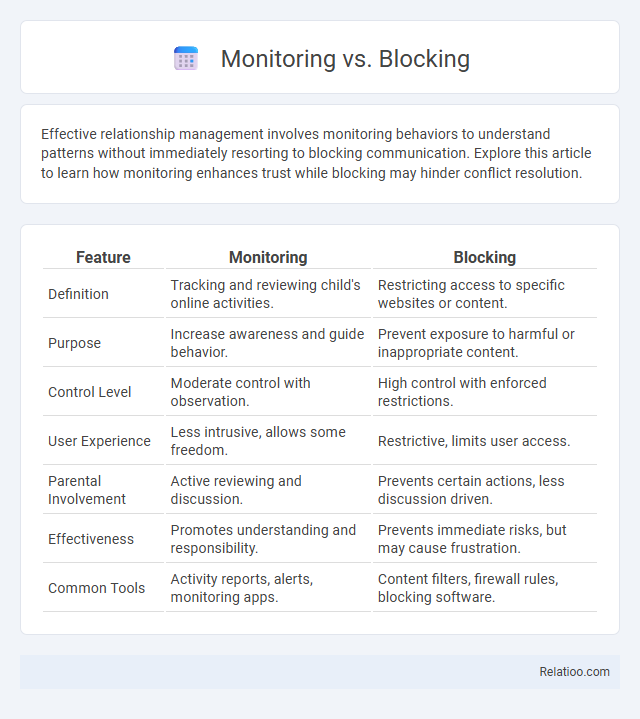Effective relationship management involves monitoring behaviors to understand patterns without immediately resorting to blocking communication. Explore this article to learn how monitoring enhances trust while blocking may hinder conflict resolution.
Table of Comparison
| Feature | Monitoring | Blocking |
|---|---|---|
| Definition | Tracking and reviewing child's online activities. | Restricting access to specific websites or content. |
| Purpose | Increase awareness and guide behavior. | Prevent exposure to harmful or inappropriate content. |
| Control Level | Moderate control with observation. | High control with enforced restrictions. |
| User Experience | Less intrusive, allows some freedom. | Restrictive, limits user access. |
| Parental Involvement | Active reviewing and discussion. | Prevents certain actions, less discussion driven. |
| Effectiveness | Promotes understanding and responsibility. | Prevents immediate risks, but may cause frustration. |
| Common Tools | Activity reports, alerts, monitoring apps. | Content filters, firewall rules, blocking software. |
Introduction to Monitoring and Blocking
Monitoring tracks online activity to provide insights into how devices and applications are used, helping parents and employers ensure safe and appropriate behavior. Blocking restricts access to specific websites, apps, or content categories to prevent exposure to harmful or distracting material. Your choice between monitoring and blocking depends on whether you prefer visibility into usage patterns or proactive prevention of access to undesirable content.
Key Differences Between Monitoring and Blocking
Monitoring tracks your child's online activities to provide insights without restricting access, while blocking actively restricts or denies access to specific websites or apps. Monitoring emphasizes observation and reporting, enabling parents to understand behavior patterns, whereas blocking enforces direct content control to prevent exposure to harmful or inappropriate material. Choosing between monitoring and blocking depends on your goals for supervision and the level of internet freedom you wish to grant.
Benefits of Monitoring
Monitoring provides valuable insights into your child's online activities, enabling proactive identification of potential risks such as cyberbullying, inappropriate content, or excessive screen time. By tracking usage patterns and digital behavior, monitoring helps build trust and supports open communication between you and your child. This approach balances safety with privacy, allowing timely interventions without completely restricting access.
Advantages of Blocking
Blocking offers a powerful way to protect Your digital environment by preventing access to harmful or inappropriate content before it reaches you. Unlike monitoring, which only tracks activity, blocking proactively enforces safety measures, reducing the risk of exposure to cyber threats and distractions. This approach enhances security and productivity, ensuring users stay within safe and designated online boundaries.
Use Cases for Monitoring
Monitoring enables you to track online activity, app usage, and screen time to gain insights into digital behavior without restricting access, making it ideal for understanding patterns and ensuring safety. Use cases for monitoring include detecting cyberbullying, identifying inappropriate content consumption, and overseeing overall device usage in real-time. Unlike blocking or parental control that limits functionality, monitoring provides a comprehensive view to intervene proactively based on observed behavior.
Use Cases for Blocking
Blocking restricts access to specific websites, apps, or content categories, preventing exposure to harmful or inappropriate material. You can use blocking to enforce safe browsing environments, protect children from explicit content, and manage screen time effectively. This method is essential for schools and workplaces aiming to maintain productivity and ensure compliance with digital safety policies.
Potential Risks of Monitoring
Monitoring software can expose users to privacy invasion risks by collecting sensitive data without explicit consent, potentially leading to misuse or unauthorized access. Continuous surveillance may also cause emotional distress or erode trust between parents and children, impacting their relationship dynamics. Unlike blocking or parental controls that restrict access, monitoring focuses on observation, which, if mishandled, can result in significant ethical and security concerns.
Potential Drawbacks of Blocking
Blocking restricts access to websites and content but can lead to over-censorship, limiting educational and beneficial resources unintentionally. It may also cause frustration and encourage users to find workarounds, reducing effectiveness and undermining trust in digital safety measures. Unlike monitoring or parental control tools, blocking lacks flexibility and granular control, potentially hindering healthy exploration and learning online.
Choosing Between Monitoring and Blocking
Choosing between monitoring and blocking depends on your goals for internet safety; monitoring allows you to track your child's online activity without restricting access, providing insight into behavior patterns. Blocking, however, enforces strict limits by preventing access to specific websites or content, ensuring immediate protection from harmful material. Your decision should balance the need for oversight with the importance of fostering trust and autonomy.
Best Practices for Implementation
Effective implementation of monitoring, blocking, and parental control requires a balance between protecting users and respecting privacy. Monitoring tools should focus on real-time activity tracking with clear user consent, while blocking mechanisms must be regularly updated to filter harmful content accurately without over-censorship. Parental controls are best implemented through customizable settings that adapt to a child's age and maturity level, combined with open communication to foster digital literacy and responsible usage.

Infographic: Monitoring vs Blocking
 relatioo.com
relatioo.com